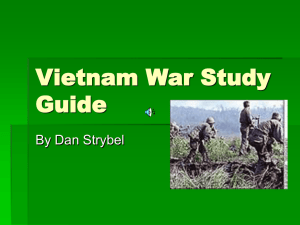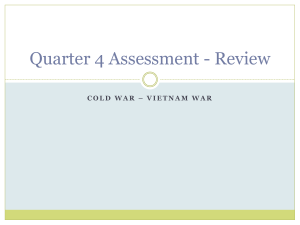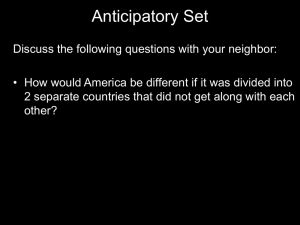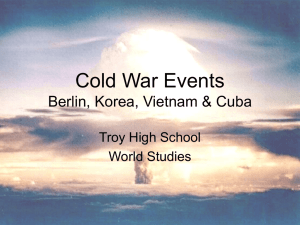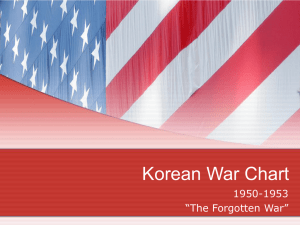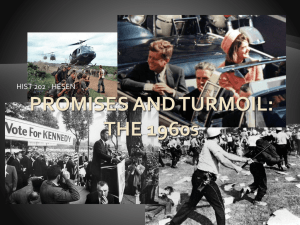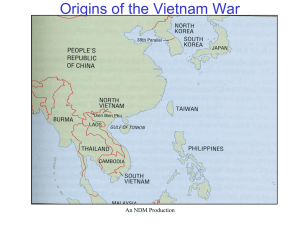Wars: Korea and Vietnam
advertisement
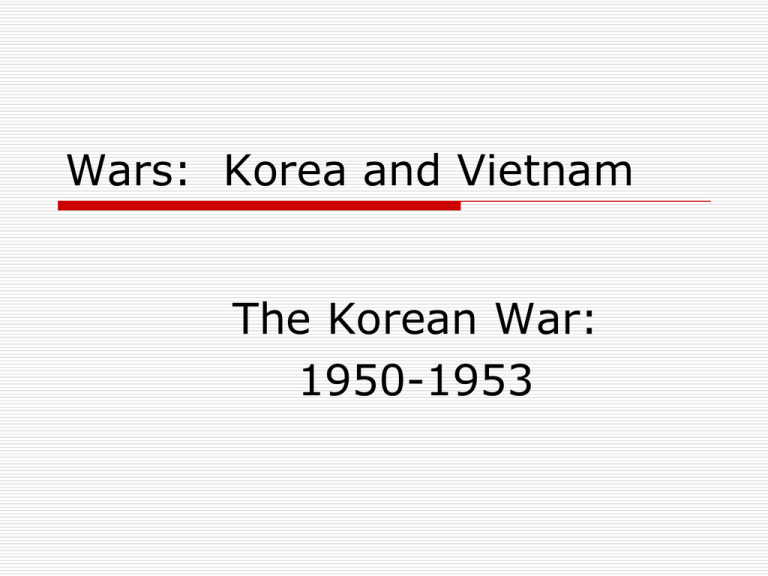
Wars: Korea and Vietnam The Korean War: 1950-1953 38th Parallel After WWII – Korea is a divided nation 38th Parallel divides North: the Japanese surrendered to the Soviets (Communist) South: surrendered to the U.S. Standoff 1949 Most troops from U.S. and Soviet R. were withdrawn Gamble: Soviets did not think U.S. would defend S. Korea – so they armed the North to take over. Surprise Attack 1950 N. Korea crossed the 38th Parallel and attacked S. Korea Pres. Truman was determined to keep S. Korea non-communist S. Korea sought help from the UN Soviets were absent in protest – could not veto any votes 15 nations (incl. U.S. and Britain) participated in helping S. Korea Douglas MacArthur Was in charge 1950 – launched a surprise attack “Pincer Action” – troops moving north from Pusan (noncommunist) met amphibian landing at Inchon. Half of the North Koreans surrendered – the rest retreated. The Fighting Continues The UN troops (mainly U.S.) pursued the retreating N. Koreans back to N. Korea to the Chinese border 1950 – the Chinese felt threatened and sent 300,000 troops into N. Korea They outnumbered the UN troops and drove the U.N. and S. Korean troops out of N. Korea. Then, they captured the S. Korean capital of Seoul. “We face an entirely new war.” D. MacArthur MacArthur wanted a nuclear attack against China. Truman thought this reckless – said no. MacArthur went to Congress and the press. Truman removed him. Next Two Years…… UN forces fought to drive the Chinese and N. Koreans back. 1952 – UN troops regain control of S. Korea 1953 – UN forces and N. Korea signed a cease-fire agreement The border was set again near the 38th parallel. 4 million soldiers and civilians had died. Aftermath Korea remained divided; a demilitarized (no military activity) zone; it still exists North Korea – Kim Il Sung – communist and established collective farms He developed heavy industry and built up the military. Died - 1994 Next North Korean Leader Sung’s son, Kim Jong Il, took over. Developed nuclear weapons – had serious economic problems South Korea Prospered because of massive aid from U.S. and other countries who were anti-communist 1960s – concentrated on developing industry and foreign trade 1987 – free elections 1980s – 90s: S. Korea had one of the highest econ. growth rates in the world. Today…. North and South Korea still divided over political differences N. Korea’s possession of nuclear weapons is a major obstacle. The U.S. still keeps troops in S. Korea *** You Tube Video 28:24 The Korean War 1950-53 The Vietnam War 1957 - 1973 Vietnam Stemmed from Cold War ‘Containment’ policy After WW2, stopping communism was the goal of U.S. foreign policy Ho Chi Minh Early 1900s – France controlled most of Southeast Asia aka Indochina (now Vietnam, Laos, and Cambodia) Vietnam= resourcerich Nationalist independence Movement began Ho Chi Minh = leader -He turned to Communists for help -1930s: his Indochinese Communist Party led revolts against the French -The French jailed protesters; also sentenced Ho Chi Minh to death -He fled into exile; returned to Vietnam in 1941 -Japanese had control of during WW2 -Ho and other nationalists founded the Vietminh (Independence) League -1945 – Defeated, the Japanese were forced out of Vietnam, -Ho Chi Minh thought they would have independence -The French wanted to regain Vietnam as its colony The Fighting Begins Vietnamese Nationalists and Communists joined to fight the French French held most major cities Vietminh had widespread countryside support Vietminh used hit-and-run tactics to confine the French to the cities 1954 – major French defeat at Dien Bien Phu French surrendered to Ho Domino Theory Because of the French defeat, U.S. saw a threat to the rest of Asia President Eisenhower: the SE Asian nations were like a row of dominoes The fall of one to communism, would lead to the fall of its neighbors This was the major justification for U.S. foreign policy during the Cold War A Divided Country After Fr. Defeat – international peace conference in Geneva To discuss the future of Indochina Vietnam was divided at 17degree north latitude Leaders North: Ho Chi Minh and Communist forces South: the U.S. and France set up an anti-Communist govt. under… Ngo Dinh Diem he became a dictator Vietcong Opposition to Diem’s govt. grew Vietcong: were Communist guerrillas - trained soldiers from N. Vietnam Most were S. Vietnamese who hated Diem Gradually the Vietcong won control of the large areas of the countryside 1963 – a group of S. Vietnamese generals had Diem assassinated. New leaders were just as bad as Diem A takeover by the Communist Vietcong, backed by N. Vietnam was inevitable The U.S. Gets Involved 1964 – Pres. Lyndon Johnson told Congress that two U.S. destroyers were attacked by the N. Vietnamese – Gulf of Tonkin Congress gave the okay to have U.S. troops go into Vietnam 1965 – 185,000 U.S. soldiers were in Vietnam U.S. planes had begun to bomb N. Vietnam 1968 – more than half a million U.S. soldiers were in combat there. Two Major Problems for the U.S. U.S. troops were the best equipped and most advanced, but… 1. Guerrilla warfare was new to them Unfamiliar country 2. S. Vietnam (U.S. was fighting for them) was unpopular U.S. Air Power Unable to win a victory on ground – U.S. used air power Bombed millions of acres of farmland and forests – to destroy enemy hideouts This made peasants hate S. Vietnam even more and opposed their government The United States Withdraws Late 1960s – U.S. citizens protested war – too much loss of life 1969 - Pres. Richard Nixon starts withdrawing U.S. troops from Vietnam in 1969 Vietnamization U.S. troops would gradually pull out giving South Vietnam an increased combat role Nixon authorized a massive bombing campaign against N. Vietnam bases and supply routes Also authorized bombing of Laos and Cambodia to destroy Vietcong hideouts Because of U.S. protesting, Nixon kept withdrawing U.S. troops 1973 – the last U.S. troops left Two years later – N. Vietnam overran S. Vietnam 1.5 million Vietnamese died 58,000 Americans died Draft Protests 18-26 years of age 366 blue plastic capsules contained the birthdays that would be chosen in the first Vietnam draft lottery drawing on December 1, 1969. The first birth date drawn that night, assigned the lowest number, "001," was September 14. (Selective Service Archive) How to avoid being drafted: Student or medical deferments Other reasons (hardship) Volunteered Fled to Canada Kent State – May 4, 1970 When Pres. Nixon okayed the invasion of Cambodian to destroy Vietnamese Communist bases U.S. nationwide protest on college campuses Military was sent to Kent State 4 students died 9 wounded U.S. was shocked **** You Tube Kent State Shooting: 40 years later 3:59 Vietnam Memorial – Wash. DC *** L360 U.S. Vietnam War 28:27 Wars: Assignment: Draw a Venn diagram and compare and contrast the Korean and Vietnam Wars.
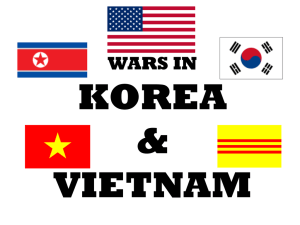
![vietnam[1].](http://s2.studylib.net/store/data/005329784_1-42b2e9fc4f7c73463c31fd4de82c4fa3-300x300.png)
